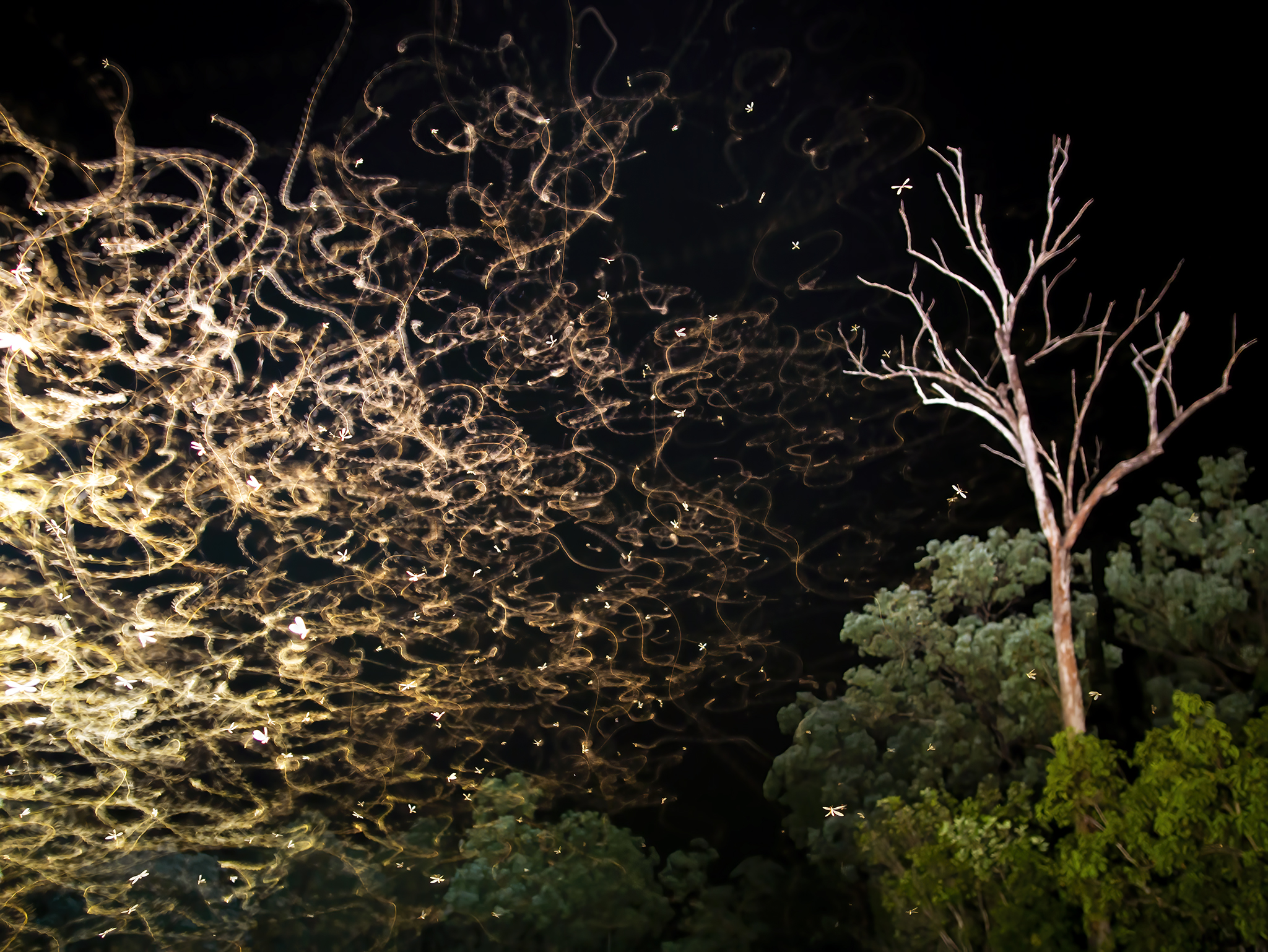This seemingly mystical photograph is in fact a long exposure image of one of the most impressive single-night events in the animal kingdom, the nuptial flight of the termite. We’ll get to what on earth a nuptial flight is – as well as a few of the animals that benefit from them – in a little while. But let’s start with an overview of termites, because in and of themselves, they are absolutely bonkers.

Termites have a reputation as pests, and while you should definitely keep an eye out for them in your home, wild termites play a vital role in our ecosystem. Termites are detritivores, meaning they consume mostly dead plants, and help to break down and recycle waste material in their habitat.
Termite colonies have a king and queen which mate for life and produce workers, soldiers and winged termites called ‘alates’ (remember that, these guys will be important later on). A mature queen in some termite species can produce up to 30,000 eggs per day – that’s one egg every 2 or 3 seconds. Queens can live for decades, with peak egg-production lasting 10 to 15 years. That means that over the course of her life, she can produce well in excess of 100 million termites!
Roughly once a year, the alates (winged termites) take part in a nuptial flight.
Millions of termites from countless colonies – often across multiple species – leave their nests simultaneously on the journey of a lifetime. The timelapses above demonstrate the sheer abundance of termites that take part in the expedition.
Each and every termite in these sequences has only one goal in mind – find a partner and start a new termite colony. Termites across vast areas even have the ability to synchronise their nuptial flights so as to increase the genetic diversity of future colonies.

So the termites taking part in the nuptial flight are all on a mission to find another termite that they can start a colony with. But what happens once they find a partner is particularly fascinating.
As mentioned, all the termites involved in the nuptial flight are winged termites – or alates. These termites are specifically bred to be able to leave the colony on a nuptial flight, an essential component in the termites’ quest for global domination.
But what do you do if you’re an alate that’s finally found love? You’ve grown these wings to help you soar to new and mysterious places, but now you’ve found that special someone and you’re ready to settle down and pump out 30,000 babies a day for the next 10 to 15 years. You don’t need those wings anymore. You’re not going anywhere.
Once a pair of alates have found each other, they both shed their wings, burrow into the ground and attempt to begin a new colony. So yes, the lonely termite in the picture above is searching for a partner whilst walking on the severed wings of the countless termites who have already found true love.
This is the kind of hard-hitting, gut-wrenching photojournalism that this site is all about.

Now I mentioned that a termite queen can single-handedly produce over 100 million babies in her lifetime, and that each set of four discarded wings represents a termite pair that are attempting to start a colony together – and I know what you’re thinking. You know how exponential growth works. Why isn’t the entire planet just a giant ball of termites?
Well, if you thought that the lone termite walking across a bed of discarded wings that literally symbolise his failure to find love was depressing, we’re just getting started!
The thing is that while this story may sound like a magical journey where termites find love and continue the circle of life, in reality – like most realities in the animal kingdom – the truth is much more brutal.
Only a very small percentage of termites produced by a colony are alates (the vast majority are workers); only a very small percentage of alates survive a nuptial flight long enough to find a mate; and only a very small percentage of those mating pairs survive long enough to produce successful colonies.
What causes so many to die? Well, you can probably guess!

Imagine for a moment that you’re an animal with a varied diet, who on occasion doesn’t mind partaking in a tasty termite. Now think about what you would do if one night, suddenly, thousands upon thousands of termites appeared out of nowhere. Naturally, you’d eat as many termites as you possibly could, and if you were smart enough, you’d kill a few extra and store them for later.
This is why so few termites survive long enough to establish a successful new colony. The nuptial flight of the termite provides an absolute smorgasbord for other animals!
For instance, the adorable Long-Haired Rat pictured above is usually pretty well-hidden and camera-shy, but even he had decided that the payoff was worth the risk on nuptial flight night. He completely ignored me as I took photos of him gorging himself on the abundance of termites. The same went for a myriad of other predators – from geckos and frogs to cane toads and birds.
But some of the most ingenious tacticians were to be found in the invertebrate world…

One species of spider was particularly well-prepared to make the most of nuptial flight night. A Garden Orb Weaver we spotted had produced a gigantic web, almost two metres in diameter, and was reaping the rewards of an endless supply of termites. She waited in the centre of her web until one inevitably flew into her trap, then raced over to it and immobilised it within seconds. She’d then drag it back to the centre and begin to devour it.
But supply was outstripping demand in the web. She would rarely have time to finish consuming her prey before another hapless termite became ensnared, and the cycle would repeat. When we arrived it was clear she’d already eaten several of them, and at one count she had an additional 14 termites wrapped up and ready to go for later.
The pair of termites above were still alive when I photographed them, twitching occasionally as they awaited their fate…

By far the most impressive animal to reap the rewards of nuptial flight night, however, was the Trap-Jaw Ant.
Trap-Jaw Ants have jaws that open to 180 degrees and have the second-fastest bite in the animal kingdom (second only to the Dracula Ant). One species of Trap-Jaw Ant was recorded closing its jaws at speeds of up to 230km/h. In fact, if you were to say, “Wow! That ant closed its jaw in the blink of an eye”, you’d be significantly under-estimating. The Trap-Jaw Ant closes its jaw at more than 2,000 times the speed of the blink of an eye.
When termite alates started appearing, the Trap-Jaw Ants leapt into action as a colony to take down as many as they could. When a termite landed on the ground, one ant would immediately rush to it and clamp its jaws on a wing, preventing it from flying away. With jaws locked onto the wing, the ant would then wrap its body around in order to sting the termite. After successful envenomation, the ant only needed to hang on for a few more seconds before the termite would collapse. Now fully paralysed, a few more stings would quickly finish the job – and all of this despite the termite often being three or four times the size of the ant.
All of the Trap-Jaw Ants had obviously been given the same instructions – take out as many termites as you can while the nuptial flight was occurring. Hundreds of bodies lay on the battlefield as the massacre continued. It was clear that collecting the termites and taking them to the colony was a problem to be dealt with later.
The dramatic image above highlights the remarkable hunting mechanisms – both jaw and stinger – that Trap-Jaw Ants have evolved, allowing them to take incredible advantage of the termites’ nuptial flight.

This is one of the longest posts I’ve put up, and that’s because the more I learned about the nuptial flight of the termite (and the other species that benefit from it), the more information I felt compelled to include.
Just to recap:
- Termites mate for life and an established termite queen can lay an egg every 3 seconds for 15 years.
- Roughly once a year, winged termites called alates from multiple colonies take part in a nuptial flight.
- After finding a mate, the alates shed their wings and attempt to begin a new colony.
- For the vast majority of termites involved in the nuptial flight, it is the last thing they ever do – only a tiny percentage succeed in forming a new colony.
- Those that fail provide an absolute smorgasbord of food for termite predators, from rodents and frogs, to lizards and insects.
And all this was focused on just a single night in the life of a termite. We didn’t even get into the complexity of the rest of their lives, like the fact they farm fungus in mounds with sophisticated air-conditioning systems that can reach up to five metres tall!
Termites are truly remarkable creatures and we will definitely be revisiting them again in future posts.


